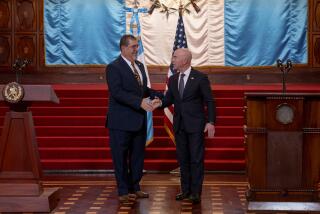Peace Through a Better Bottom Line : Building a Common Market for Central America
Even in the best of times, relations between the nations of Central America have been strained. As often as Guatemala, El Salvador, Honduras, Nicaragua and Costa Rica have lashed out at an internal insurgency or put down a coup attempt, they have fought one another. Like peace, economic cooperation has eluded the five republics.
Yet nothing is as crucial as economic development in reducing the region’s turmoil. At their summit meeting last week, Central America’s presidents took a potentially important step toward that goal.
Symbolically, they met in the colonial city of Antigua, Guatemala--briefly the isthmus’ capital when the nations broke away from the Spanish empire. There they announced a plan to revive a regional common market that foundered 20 years ago amid indifference and internecine squabbling. Much has changed in the interim. All Latin American countries are softening their fierce financial nationalism and trying to pare down bloated public sectors. More sobering, the regional guerrilla wars that have claimed about 150,000 lives have left all five economies in financial ruin.
The plan announced at the summit calls for lowering trade barriers, rebuilding infrastructure and slashing Central America’s combined $20-billion foreign debt. The idea is to transform the tiny “after-dinner economies” into one viable financial entity. It has a better chance for success than the debacle of the 1960s because nobody wants to relive the turmoil of the two ensuing decades.
Inevitably, much rests on the support of the hemisphere’s dominant power--the United States. So it is reassuring that Washington’s initial reaction to the agreement was positive, if vague. Secretary of State James A. Baker III joined the presidents Monday and chimed in with his own proposal: that U.S., European and Japanese aid to the region be channeled through a multilateral commission.
That’s a good idea but it stops short of addressing some longstanding points of discord. For instance, Washington and Central America disagree on who will administer the aid and what conditions will be attached to it. Some big thinkers in Washington seem interested only in rapid privatization in the region: Great in theory but painful in practice as even big Latin economies like Brazil and Mexico are finding out. Given the destitution that 30 million Central Americans already endure, their leaders are less-than-enthusiastic about jumping right into the frigid waters of free-market economics. For another, El Salvador is angered that the United States may condition aid on improved human-rights conditions. Lastly, Central Americans can’t forget that many promises made under former President Reagan’s Caribbean Basin Initiative were rendered meaningless by U.S. protectionism.
So the Central Americans must cast off their tradition of bickering and see that this proposal for a new common market on the isthmus goes forward. Because the financial well-being it could promote throughout the region will help correct the social injustice that fueled the recent warfare. Although the Contra war that bloodied Nicaragua seems to have ended, fighting goes on in El Salvador, and Guatemala’s 30-year-old guerrilla war is regaining momentum. Human-rights abuses are on the rise in Honduras. Regionally, drug-traffickers are more active than ever.
Finding a lasting peace in a region that has known largely bloodshed for most of its history will be easier as the economic roots of social unrest are reduced.
More to Read
Sign up for Essential California
The most important California stories and recommendations in your inbox every morning.
You may occasionally receive promotional content from the Los Angeles Times.










